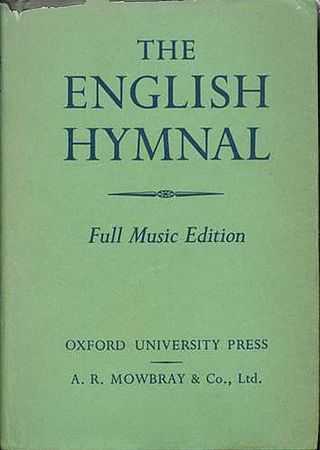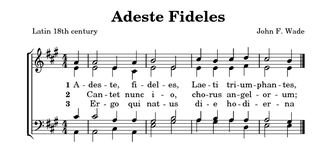Related Research Articles
Christian music is music that has been written to express either personal or a communal belief regarding Christian life and faith. Common themes of Christian music include praise, worship, penitence and lament, and its forms vary widely around the world. Church music, hymnals, gospel and worship music are a part of Christian media and also include contemporary Christian music which itself supports numerous Christian styles of music, including hip hop, rock, contemporary worship and urban contemporary gospel.

Daniel Laurent Schutte is an American composer of Catholic and contemporary Christian liturgical music, best known for composing the hymn "Here I Am, Lord" and approximately 171 other hymns and Mass settings.

The English Hymnal is a hymn book which was published in 1906 for the Church of England by Oxford University Press. It was edited by the clergyman and writer Percy Dearmer and the composer and music historian Ralph Vaughan Williams, and was a significant publication in the history of Anglican church music.

Oregon Catholic Press is a publisher of Catholic liturgical music based in Portland, Oregon. It published the newspapers Catholic Sentinel and El Centinela; both papers have been discontinued effective October 1, 2022.
Decisions concerning the conduct of public worship in the Church of Scotland are entirely at the discretion of the parish minister. As a result, a wide variety of musical resources are used. However, at various times in its history, the General Assembly has commissioned volumes of psalms and hymns for use by congregations.
The St. Louis Jesuits are a group of Catholic composers who composed music for worship most often in a folk music style of church music in their compositions and recordings, mainly from their heyday in the 1970s through the mid-1980s. Made up of Jesuit scholastics at St. Louis University, the group initially used acoustic guitars and contemporary-style melodies and rhythms to set biblical and other religious texts to music sung in English in response to the liturgical reforms of the Second Vatican Council.
Contemporary Catholic liturgical music encompasses a comprehensive variety of styles of music for Catholic liturgy that grew both before and after the reforms of the Second Vatican Council. The dominant style in English-speaking Canada and the United States began as Gregorian chant and folk hymns, superseded after the 1970s by a folk-based musical genre, generally acoustic and often slow in tempo, but that has evolved into a broad contemporary range of styles reflective of certain aspects of age, culture, and language. There is a marked difference between this style and those that were both common and valued in Catholic churches before Vatican II.
Hymns are an important part of the history and worship of the Church of Jesus Christ of Latter-day Saints.

Hymns of the Church of Jesus Christ of Latter-day Saints is the official hymnal of the Church of Jesus Christ of Latter-day Saints . Published in English in 1985, and later in many other languages, it is used throughout the LDS Church. This article refers to the English version. The book was published on the 150th anniversary of the publication of the first LDS hymnbook, compiled by Emma Smith in 1835. Previous hymnbooks used by the church include The Manchester Hymnal (1840), The Psalmody (1889), Songs of Zion (1908), Hymns (1927), and Hymns (1948).

Pequeñas anécdotas sobre las instituciones is the third album of Argentine group Sui Generis, released in 1974 by the Talent label.

A hymn tune is the melody of a musical composition to which a hymn text is sung. Musically speaking, a hymn is generally understood to have four-part harmony, a fast harmonic rhythm, with or without refrain or chorus.

Suscipe is the Latin word for 'receive'. While the term was popularized by St. Ignatius of Loyola, founder of the Society of Jesus, who incorporated it into his Spiritual Exercises in the early sixteenth century, it goes back to monastic profession, in reciting Psalm 119. This article focuses rather on its popularization through the Exercises and through the Roman Missal, where it introduces the Canon of the Mass.
Cesáreo Gabaráin was a Spanish Catholic priest and composer of liturgical songs such as Pescador de hombres. He received a Gold Record award in Spain, and his music is well known and sung by English- and Spanish-speaking people. Gabaráin became a hymn-writer when he was thirty and went on to write about five hundred songs. He tried to write songs that were easy to learn and be sung by the entire congregation. His hymns have cited as supportive in moments of personal and communal prayer and praise to God, but were sullied by credible published reports that Gabaráin sexually abused schoolboys in the 1970s.

Héroes del Silencio was a Spanish rock band from Zaragoza, formed by guitarist Juan Valdivia and singer Enrique Bunbury. The lineup was completed by bassist Joaquín Cardiel and drummer Pedro Andreu. During the 1980s they experienced success around Spain and the Americas, and in various European countries including Germany, Belgium, Switzerland, France, Yugoslavia, and Portugal. They established themselves as one of the major contributors to the Rock en español scene and are considered to be one of the all-time best bands in that genre. Their trademarks are their intricate lyrics, complicated arrangements and precise rhythm. After twelve years and numerous albums, the band broke up in 1996. When the lead singer Enrique Bunbury started a solo project, other members of the band also followed a different musical path. In 2007, as part of a 20-year anniversary celebration and 11 years after their break-up, they organized a 10-concert world tour.
Jackie Francois is an American Christian musician, singer, songwriter, guitarist, speaker, and youth minister from Placentia, California. It was through her involvement with Life Teen that led Francois to engage in various retreats, conferences, and World Youth Day gatherings. From these, Francois came to be more involved in her Catholic faith, which is reflected in her musical and ministerial work. Her debut album, Your Kingdom is Glorious, was released in 2008, followed by the release of a second album, Divine Comedy, in mid-2012.

"What Wondrous Love Is This" is a Christian folk hymn from the American South. Its text was first published in 1811, during the Second Great Awakening, and its melody derived from a popular English ballad. Today it is a widely known hymn included in hymnals of many Christian denominations.

GIA Publications, Inc. is a major publisher of hymnals, other sacred music, and music education materials that is currently located in Chicago. The organization was initially the publishing arm of the Gregorian Institute of America (1941–1965); a school affiliated with the Roman Catholic Church that was initially established in Pittsburgh but operated for the majority of its history in Toledo, Ohio. The school specialized in training choral conductors in the methods of teaching choirs to sing Gregorian chant. After the school's closure following the Second Vatican Council, the publishing part of the school was sold to the Harris family.

Kirchenlied is a German Catholic hymnal published in 1938. It was a collection of 140 old and new songs, including hymns by Protestant authors. It was the seed for a common Catholic hymnal which was realised decades later, in the Gotteslob (1975).

"Nun danket all und bringet Ehr" is a German Lutheran hymn in nine stanzas, with a text written by Paul Gerhardt. It was first published in 1647, in Johann Crüger's Praxis pietatis melica which was the first publication of hymns by Gerhardt. In the 1653 edition, Crüger added a melody that he composed. As a general song of thanks, the song has appeared in several hymnals, including the German Protestant hymnal Evangelisches Gesangbuch and the Catholic hymnal Gotteslob. It has inspired musical settings by composers from the 17th to the 21st century. Johann Sebastian Bach used the first stanza in a cantata, however with the melody of "Lobt Gott, ihr Christen alle gleich", Hugo Distler composed a chorale cantata, and Günter Berger based a toccata for organ on it.
References
- ↑ Maxwell E. Johnson - 2002 The Virgin of Guadalupe: Theological Reflections Page 132 0742522849 Flor y Canto is published by Oregon Catholic Press (OCP) and contains most of the familiar music used at this celebration and on Sunday mornings. Other music is remembered from celebrations representing the various local traditions, and at times newer compositions published by OCP are also used. The majority of traditional Marian